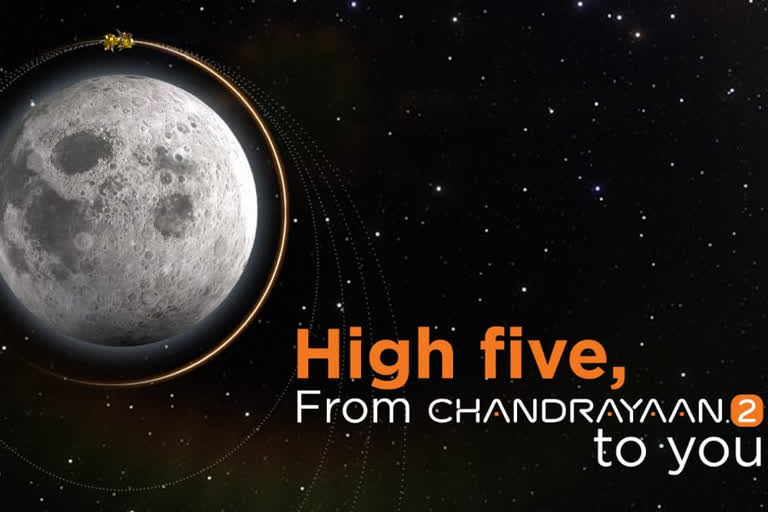Bengaluru: ISRO on Monday said it has successfully performed the separation of lander 'Vikram' from Chandrayaan-2 Orbiter at 1315 hrs.
The news of the successful separation of lander Vikram from Chandrayan 2 has shared by ISRO in its official twitter handle.
-
#ISRO
— ISRO (@isro) September 2, 2019 " class="align-text-top noRightClick twitterSection" data="
Vikram Lander Successfully separates from #Chandrayaan2 Orbiter today (September 02, 2019) at 1315 hrs IST.
For details please visit https://t.co/mSgp79R8YP pic.twitter.com/jP7kIwuZxH
">#ISRO
— ISRO (@isro) September 2, 2019
Vikram Lander Successfully separates from #Chandrayaan2 Orbiter today (September 02, 2019) at 1315 hrs IST.
For details please visit https://t.co/mSgp79R8YP pic.twitter.com/jP7kIwuZxH#ISRO
— ISRO (@isro) September 2, 2019
Vikram Lander Successfully separates from #Chandrayaan2 Orbiter today (September 02, 2019) at 1315 hrs IST.
For details please visit https://t.co/mSgp79R8YP pic.twitter.com/jP7kIwuZxH
All spacecraft parameters are normal, the Bengaluru headquartered space agency said after Sunday's manoeuvre on the spacecraft, that is currently in the lunar orbit for its rendezvous with the Moon.
Vikram (with rover 'Pragyan' housed inside) is expected to touch down on the lunar surface on September 7, between 1.30 AM and 2.30 am.
ISRO said that after the lander's separation on Monday, two deorbit manoeuvres are scheduled for September 3 (9:00-10:00) and September 4 (3:00-4:00) respectively, before the powered decent on September 7.
ISRO Chairman K Sivan has said the proposed soft-landing on the Moon would be a "terrifying" moment as it is something ISRO has not done before, whereas the Lunar Orbit Insertion manoeuvre was successfully carried out during the Chandrayaan-1 mission.
In a major milestone for India's second Moon mission, the Chandrayaan-2 spacecraft had successfully entered the lunar orbit on August 20 by performing the LOI manoeuvre.
Chandrayaan-2 satellite began its journey towards the moon, leaving the earth's orbit in the dark hours on August 14, after a crucial manoeuvre called Trans Lunar Insertion (TLI) carried out by ISRO to place the spacecraft on "Lunar Transfer Trajectory".
India's Geosynchronous Satellite Launch Vehicle, GSLV MkIII-M1 had successfully launched the 3,840-kg Chandrayaan-2 spacecraft into the earth's orbit on July 22.
The spacecraft's health is being continuously monitored from the Mission Operations Complex at ISRO Telemetry, Tracking and Command Network in Bengaluru with support from Indian Deep Space Network antennas at Bylalu, near Bengaluru, the space agency has said.
Following the landing, the rover 'Pragyan' will roll out from lander 'Vikram' between 5:30-6:30 am on September 7 and carry out experiments on the lunar surface for a period of one lunar day, which is equal to 14 earth days.
The mission life of the lander is also one lunar day, while the orbiter will continue its mission for a year.
The orbiter carries eight scientific payloads for mapping the lunar surface and study the exosphere (outer atmosphere) of the Moon while the lander carries three scientific payloads to conduct surface and subsurface science experiments.
The rover carries two payloads to enhance the understanding of the lunar surface.
India's second lunar expedition would shed light on a completely unexplored section of the Moon, it's9+ South Polar region.
ISRO has said that the mission objective of Chandrayaan-2 is to develop and demonstrate the key technologies for end-to-end lunar mission capability, including soft-landing and roving on the lunar surface.
On the science front, the mission aims to further expand the knowledge about the moon through a detailed study of its topography, mineralogy, surface chemical composition, thermo-physical characteristics and atmosphere, leading to a better understanding of the origin and evolution of the moon, the space agency had said.
Also Read: Chandrayaan-2 gets closer to the moon




